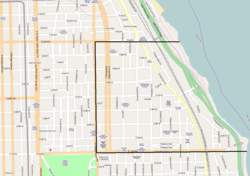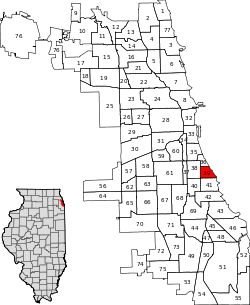Kenwood, Chicago
| Kenwood | |
|---|---|
| Community area | |
| Community Area 39 - Kenwood | |
|
| |
 Streetmap | |
 Location within the city of Chicago | |
| Coordinates: 41°48.6′N 87°36.0′W / 41.8100°N 87.6000°WCoordinates: 41°48.6′N 87°36.0′W / 41.8100°N 87.6000°W | |
| Country | United States |
| State | Illinois |
| County | Cook |
| City | Chicago |
| Neighborhoods | |
| Area | |
| • Total | 1.09 sq mi (2.82 km2) |
| Population (2010) | |
| • Total | 17,841 |
| • Density | 16,000/sq mi (6,300/km2) |
| Demographics 2010[1] | |
| • White | 16.5% |
| • Black | 71.9% |
| • Hispanic | 3.0% |
| • Asian | 5.4% |
| • Other | 3.2% |
| Time zone | CST (UTC-6) |
| • Summer (DST) | CDT (UTC-5) |
| ZIP Codes | parts of 60615 and 60653 |
| Median household income | $39,371[2] |
| Source: U.S. Census, Record Information Services | |
Kenwood, one of Chicago's 77 community areas, is on the shore of Lake Michigan on the South Side of the city. Its boundaries are 43rd Street, 51st Street, Cottage Grove Avenue, and the lake. Kenwood was originally part of Hyde Park Township, which was annexed to the city of Chicago in 1889. Kenwood was once one of Chicago's most affluent neighborhoods, and it still has some of the largest single-family homes in the city. It contains two Chicago Landmark districts, Kenwood and North Kenwood. A large part of the southern half of the community area is in the Hyde Park-Kenwood Historic District. In recent years, Kenwood has received national attention as the home of U.S. President Barack Obama.
Description
Kenwood was settled in the 1850s by wealthy Chicagoans seeking respite from the increasing congestion of the city. The first of these residents was John A. Kennicott, who built his home near the Illinois Central Railroad at 48th Street. He named the home Kenwood after his ancestral land in Scotland, and when the Illinois Central Railroad built a small depot near 47th Street, they named the station Kenwood as well. Shortly afterwards, the name Kenwood began to be applied to the whole area.[3]
The southeastern portion of Kenwood contains the Indian Village neighborhood, which features the Chicago Landmark Powhatan Apartments and the National Register of Historic Places Narragansett. The 1902 Blackstone Library is another well-known landmark in the neighborhood. It continues to be part of the Chicago Public Library system. The recently reopened Hyde Park Art Center, located on Cornell Avenue just north of 51st Street and East Hyde Park Boulevard, is Chicago's oldest alternative exhibition space, with an on-site school and studio.
The area that contains the Hyde Park community area and the southern half of Kenwood (south of 47th Street) is sometimes referred to as Hyde Park-Kenwood.[4]
In the 1890s, the Kenwood Astrophysical Observatory, established by astronomer George Ellery Hale, was located in Kenwood close to the new (at that time) University of Chicago.
Schools
The public schools in Kenwood are Kenwood Academy, Canter Middle School, King College Prep High School, Ariel Community Academy, and Beula Shoesmith Elementary School. Private Schools in Kenwood include the Ancona Montessori School, Cambridge School of Chicago, Akiba-Schechter Jewish Day School, and Hales Franciscan High School.
Notable residents
- Barack Obama
- Muhammad Ali
- Barbara Bowman
- Carol Moseley Braun
- David "Honeyboy" Edwards
- Louis Farrakhan
- Valerie Jarrett
- Edward Levi
- Ann Marie Lipinski
- Muddy Waters
- Gaston B. Means
- Elijah Muhammad
- Mandy Patinkin
- Maurice Rabb
- Julius Rosenwald
- Bill Veeck
- The infamous murderers Nathan Leopold and Richard Loeb, and their victim Bobby Franks
Gallery
- Lakefront condominiums in Kenwood as seen from Promontory Point.
- The headquarters of Jesse Jackson's Rainbow/PUSH
- The KAM Isaiah Israel synagogue
- The Regents Park apartment complex
| Historical population | |||
|---|---|---|---|
| Census | Pop. | %± | |
| 1930 | 26,942 | — | |
| 1940 | 29,611 | 9.9% | |
| 1950 | 35,705 | 20.6% | |
| 1960 | 41,533 | 16.3% | |
| 1970 | 26,890 | −35.3% | |
| 1980 | 21,974 | −18.3% | |
| 1990 | 18,178 | −17.3% | |
| 2000 | 18,363 | 1.0% | |
| 2010 | 17,841 | −2.8% | |
| [5] | |||
Notes
- ↑ Paral, Rob. "Chicago Demographics Data". Retrieved 12 June 2012.
- ↑ Paral, Rob. "Chicago Census Data". Retrieved 9 October 2012.
- ↑ "Encyclopedia of Chicago - Kenwood". The Electronic Encyclopedia of Chicago. Chicago Historical Society. Retrieved 21 June 2012.
- ↑ "Hyde Park-Kenwood Community Conference".
- ↑ Paral, Rob. "Chicago Community Areas Historical Data". Chicago Community Areas Historical Data. Retrieved 29 August 2012.
External links
| Wikimedia Commons has media related to Kenwood, Chicago. |
 |
Oakland, Chicago | Lake Michigan |  | |
| Grand Boulevard, Chicago | |
|||
| ||||
| | ||||
| Washington Park, Chicago | Hyde Park, Chicago |